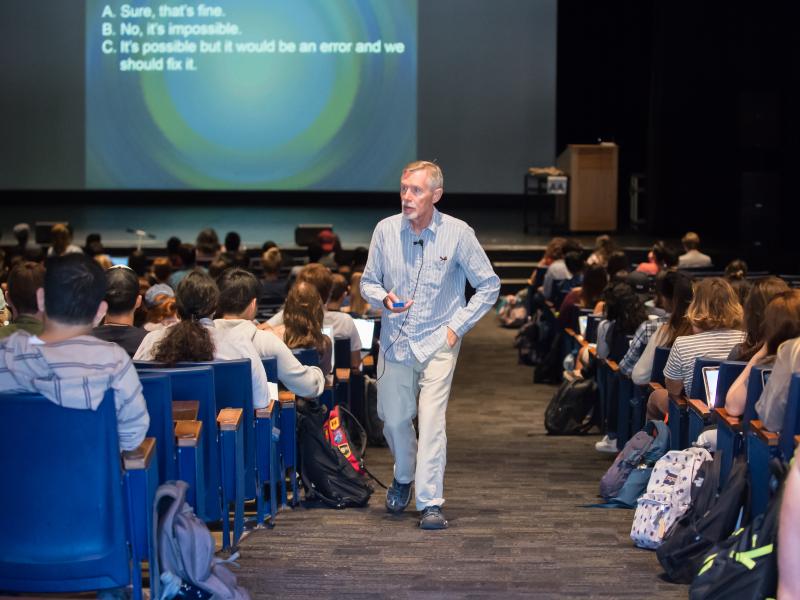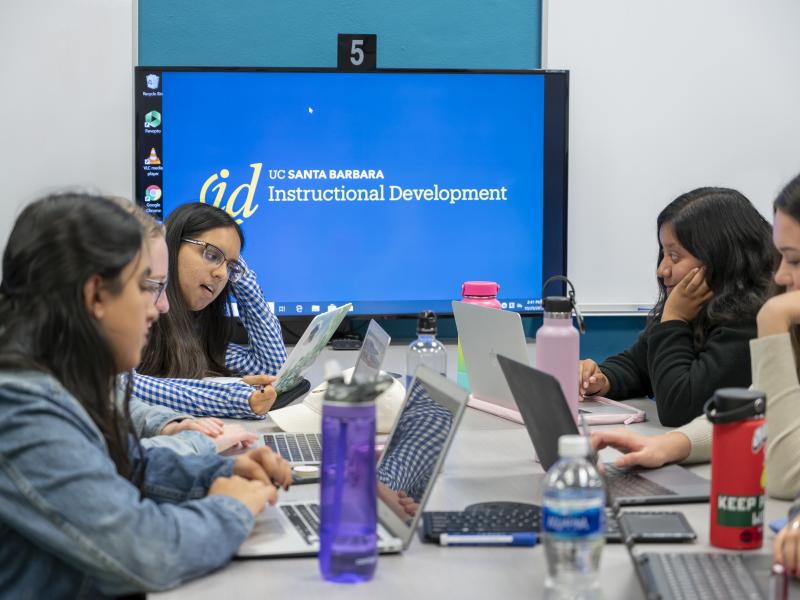Teaching hundreds of students in UCSB’s large classrooms and lecture halls is quite common on our campus. It is an experience that can feel overwhelming for both instructors and students, but with careful planning and practice, you can make it into a good experience. Below are some key pedagogical considerations, technologies, and resources to help you.
Extra Careful Planning
When there are hundreds of students poised to ask you questions about the content and course policies, you need to be as efficient and organized as possible. Your best allies are a well-organized syllabus, a predictable weekly pattern, an easy-to-navigate course site, and frequent, clear communication between instructors, TAs, and students (see our pages on course organization for details). The more organized and clear you are about course policies, instructions, due dates, and how to communicate, the fewer logistical questions you will receive, which gives you more time to spend on preparing and teaching content and checking-in on student learning. In addition, it is paramount that you align your lecture with the TA sections by working closely with your TAs to organize materials, talk about student learning, and ensure equitable grading practices. Take the necessary time to ensure that you and your TAs are on the same page or it will result in student confusion.
In that same vein, your lesson plans and teaching strategies also need to be as organized and efficient as possible because in-class activities take more time to orchestrate and conduct than in small classes.

Consider using the same types of activities in each class so students get used to behaving in particular ways (like always sitting near other people so they are ready to do small group work) or bringing particular learning tools (like having the iClicker or backchannel apps ready on their devices).
Accessibility and Being Human
Large classes are much more likely to have students with many different kinds of needs that aren’t on your official list of disabled student accommodations from Disabled Students Program (DSP). Clarifying your policies, logistics, and teaching strategies in large classes can also help mitigate common student barriers to learning that prevent access and opportunities for students who are first generation, minoritized, working parents, and/or suffering from temporary mental or physical illness. Consider the following strategies to provide the best learning environment you can for your students.
- Try to focus on how your students are different from each other. For example, how might international students, students with minor learning disabilities, or chronically ill students fall behind if they didn’t catch everything in the lecture? What might a first generation student not know about office hours or how to study for this course? What kind of flexibility for due dates and/or opportunities to ask questions outside of class might an anxious or depressed student need?
- Consider building in multiple ways to participate, student-friendly communication paths, recording and captioning lectures, and clear class policies to mitigate these barriers up front so you don’t have to deal with them on a case-by-case basis.
- Provide a way for all students to make their needs known - either anonymously or confidentially to you and/or their TA.
- Make sure the method of communication can and will be used by all students, not only the ones willing to bring up issues while in person with the instructor or TA. For example, make a digital survey available on your course site.

- Continue to assess accessibility and your students’ needs throughout the entire course, and make adjustments when needed.
Working with TAs
Large classes often include a group of TAs that assist in grading and/or teaching sections. These TAs require some extra management and coordination from the instructor. Beyond the typical TA-Instructor relationship, there are some important things to keep in mind when managing multiple TAs.
How to use a Head TA
Typically, a Head TA coordinates all other TAs, helps resolve time conflicts, and is the first point of contact for TAs about course material.
Grading as a Group
- Ensure grading criteria and student feedback is consistent across TAs.
- Hold a grading or norming session to ensure fair grading practices.
Teaching Responsibilities
- Decide how much responsibility individual TAs have for content and teaching strategies.
- Coordinate section materials, like slides, lesson plans, activities, and student support.
Check in Frequently
- Frequently check in with TAs to understand what activities may or may not work well during section.
- Consider using a text chat or backchannel for your TA group.
Classroom Community
A major challenge with large classes is creating an environment that feels welcoming and encourages students to work with the instructor and/or other students. There are different ways to develop a community in a large class atmosphere.
- Provide more personal communication between instructors and students using light-touch feedback, backchannels, and student surveys.
- Incorporate lots of opportunity for feedback using automatically graded quizzes, iClicker questions, and detailed rubrics.
- Add stopping points during lectures to ask questions, encourage students to ask questions, and engage in small group discussions about class material.
- Encourage use of office hours (maybe even call them “student hours”).
- Provide examples of what can be discussed in office hours (class related or not).
- Remind students every week about office hours.
- Remind students that office hours visits don’t need to be scheduled.
- Consider holding office hours in student spaces, like the library study rooms, UCen, a picnic table outside, or the Student Resource Building.
- Be flexible, students may have responsibilities that prevent them from attending traditional office hours.
- Have online office hours.
- Office hours outside of normal working hours.
- Individually scheduled appointments
- Discussion forums or backchannels provide spaces for students to ask other students questions about the material or get feedback on their work.
- Break up class into consistent groups throughout the quarter (or for a few weeks every quarter).
- Encourage the creation of study/support groups in your class.
- Walk through the class before class starts and strike up conversations with students.
- You and the TAs can move around the classroom during group work to chat with individual groups.
- Try to learn names.
- Use a backchannel so you can call on students by name when they ask or answer a question in the chat.
- Use name cards.
- Have students say their name first before answering/asking questions.
Technology for Large Classes
There are a lot of different types of educational technologies, however, some technologies can be especially useful in large classes, especially for assessments.
- The iClicker Cloud app helps you get quick feedback about your students’ understanding during lecture. It can also help you take attendance or provide participation points.
- Give all your students automated feedback with online quizzes quickly and efficiently by writing feedback, hints, and study tips for different answer choices on online practice quizzes.
- Use Gradescope to quickly grade written solutions, computer code, and/or multiple choice and short answer exams. Gradescope helps you create and use a common rubric with specific feedback.
- Backchannels and discussion forums can be a place for students to give peer feedback and thoughts on ideas and projects on Canvas.
- Use Google Forms to get students to contribute their ideas or small group responses, or use Google Slides Q&A to allow students to ask questions via chat during lecture.
Stage Presence
Teacher stage presence can be described as having a live and dynamic awareness of the entire classroom space and connection with those around us in a class. It is an essential part of presenting to a large class because your ability to scan the entire space with your eyes and ears will help you notice and respond to individuals and groups of students, noises, and class energy. This encourages students to engage with you, their peers, and the material. The following ideas can help you develop your stage presence.
- It can be helpful to orient yourself with a clear sense of why the information is exciting and important for the students to learn. This brings your attention to the material and away from yourself. A quick way to bring the focus of the whole class to the attention is including a free-write and class conversation at the beginning of class.
- When you are nervous about being on stage or not feeling like your normal self, consider using breathing and meditation techniques to center yourself so you can situate yourself in your surroundings and connect with students.
- Students connect better with instructors who show genuine interest and positive emotions in class. Share with students why you find the material exciting and why they should learn it to introduce genuine emotion into your classroom.
- Our brains are designed to watch and match people around us, meaning you have the power to influence how your students feel by displaying the types of emotions you want your students to mirror. Students also have the ability to influence your emotions, which is why it can be useful to connect with students who are engaged, rather than focusing on those who are disengaged.
Movement during lecture helps students pay attention because they have to track you, and it gives you an opportunity to make eye-contact with students around the room. Gestures can also be helpful to emphasize key points, indicate that you want students’ feedback, or to signal that you are listening.
Make sure to include pauses during your presentation to give students a chance to process the material and to give yourself a chance to think, reorient, and bring awareness back to the goal of the lesson if it has shifted.
The best way to develop a teaching presence is to practice lecturing. Practice changing your vocal tone, speaking to the far corners of the room, breathing and taking breaks, telling stories, and explaining content. This builds your confidence and allows your mind the mental space to be self-aware and scan the physical space. Also practice incorporating new techniques and strategies into your teaching before you try them in a large lecture to avoid mishaps.